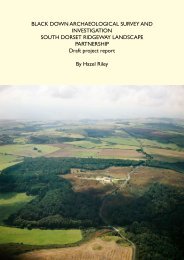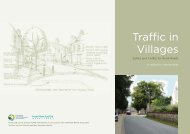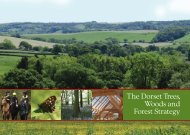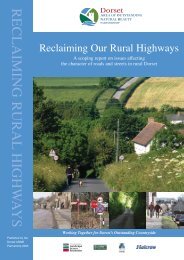guide to allotments in West Dorset (pdf, 5Mb ... - Dorsetforyou.com
guide to allotments in West Dorset (pdf, 5Mb ... - Dorsetforyou.com
guide to allotments in West Dorset (pdf, 5Mb ... - Dorsetforyou.com
You also want an ePaper? Increase the reach of your titles
YUMPU automatically turns print PDFs into web optimized ePapers that Google loves.
Allotment provision<strong>in</strong> <strong>West</strong> <strong>Dorset</strong>Map key= Parish with new <strong>allotments</strong> planned= Parish with <strong>allotments</strong> where peopletypically wait up <strong>to</strong> a year for a plot.=Parish with <strong>allotments</strong> but where peopletypically wait over a year for a plot.= No allotment provision with<strong>in</strong> parishThere are currently 1,079 allotment plots <strong>in</strong> the district butnone are vacant and 406 people are on wait<strong>in</strong>g lists-(Information correct as at Oc<strong>to</strong>ber 2008)To f<strong>in</strong>d out about <strong>allotments</strong> <strong>in</strong> your area, contact your parishor <strong>to</strong>wn clerk. Details available from www.dorset-aptc.gov.uk3
2. Assess<strong>in</strong>glocal demandEven if there is no wait<strong>in</strong>g list, the demand for<strong>allotments</strong> may still exist. Some people giveup on the idea of an allotment if their councilcannot f<strong>in</strong>d the land. Others end up rent<strong>in</strong>g aplot from another parish or jo<strong>in</strong><strong>in</strong>g thatwait<strong>in</strong>g list. This is not ideal because it putspressure on these parishes and <strong>in</strong>creases carjourneys – and carbon emissions – <strong>to</strong> andfrom the allotment site.Parish and <strong>to</strong>wn councils need <strong>to</strong> have anaccurate assessment of the demand for<strong>allotments</strong>. This can be picked up through theparish or <strong>com</strong>munity plan or by a local survey,which might also identify other parish needsthat could be met on the same site.If there are conflict<strong>in</strong>g op<strong>in</strong>ions about whatthe parish needs, these may be resolved bydivid<strong>in</strong>g the land, for example <strong>to</strong> create achildren’s play area plus an allotment site or<strong>com</strong>munity orchard. These options should beagreed and planned at the earliest stages.3. AllotmentlawUnder The Small Hold<strong>in</strong>gs and AllotmentAct 1908, it is the duty of parish and <strong>to</strong>wncouncils <strong>to</strong> provide <strong>allotments</strong> if six or morepeople on the elec<strong>to</strong>ral roll make a writtenrequest. Councils are obliged <strong>to</strong> try <strong>to</strong> f<strong>in</strong>dsuitable sites, either owned by the parish,<strong>to</strong>wn, district, county council or privatelandowners. National and local plann<strong>in</strong>gpolicy is generally supportive of theprovision of new allotment sites, and theirretention once they are established.There are three types of <strong>allotments</strong> and it’simportant <strong>to</strong> know which type you have– or are aim<strong>in</strong>g for – because they havedifferent rights:• Statu<strong>to</strong>ry <strong>allotments</strong> are protected by lawunder the Allotments Act 1925. This landis owned by parish or <strong>to</strong>wn councils andthey cannot sell it for development or useit for another purpose without thepermission of the Secretary of State.If permission is given and the land is sold,the council must provide allotmentholders with an alternative site of asimilar standard.• Temporary <strong>allotments</strong> are on land leasedby parish or <strong>to</strong>wn councils from a thirdparty such as the district or countycouncil or a private landowner. Unlikestatu<strong>to</strong>ry <strong>allotments</strong>, these <strong>allotments</strong> arenot protected from disposal. If disposaloccurs, councils are still obliged <strong>to</strong> seekother sites <strong>to</strong> meet demand fromresidents.• Private <strong>allotments</strong> have the same statusas temporary <strong>allotments</strong> but the land isowned by a charitable trust, an <strong>in</strong>dividual, abus<strong>in</strong>ess, or by a private estate.4
© George Wright54. F<strong>in</strong>d<strong>in</strong>g newlandIn some parishes a local landowner may bewill<strong>in</strong>g <strong>to</strong> lease land for new <strong>allotments</strong>.When a parish or local authority alreadyowns suitable land, convert<strong>in</strong>g the site <strong>in</strong><strong>to</strong><strong>allotments</strong> only requires a council resolutionand does not usually require plann<strong>in</strong>gpermission. If suitable publicly owned landis not available then it is worth search<strong>in</strong>gfor available land <strong>in</strong> private ownership.Sites considered for new<strong>allotments</strong> should avoidfeatures of his<strong>to</strong>rical,archaeological and natureconservation <strong>in</strong>terest.In general the larger landowners andestates may be more <strong>in</strong>cl<strong>in</strong>ed <strong>to</strong> providenew plots than the smaller landowners.Where land cannot be found via theseroutes, it will be necessary <strong>to</strong> make amore <strong>in</strong>-depth search for possible sites.
Below are some helpful tips from council clerks, the district council,landowners and allotment managers on how <strong>to</strong> f<strong>in</strong>d new land:Step 1: Researchyour landIt is vital <strong>to</strong> know precisely who owns whatland <strong>in</strong> the parish, so you know how <strong>to</strong>approach the owner. <strong>West</strong> <strong>Dorset</strong> DistrictCouncil’s technical services team and theproperty terrier at <strong>Dorset</strong> County Councilwill advise on land owned by the districtand the county councils respectively.Privately owned land can be researchedfor less than £10 at the government LandRegistry. The onl<strong>in</strong>e aerial view facilityallows you <strong>to</strong> identify patches of land. Landwill only appear at the Land Registry if ithas been registered i.e. it has changedownership with<strong>in</strong> the last 18 years.Rural land is often not registered, especiallyif it has stayed <strong>in</strong> one family for generations.In this <strong>in</strong>stance the best way <strong>to</strong> f<strong>in</strong>d out whoowns the deeds is <strong>to</strong> talk <strong>to</strong> any longstand<strong>in</strong>gresidents of the parish.In <strong>West</strong> <strong>Dorset</strong>, the view is taken that<strong>allotments</strong> do not require plann<strong>in</strong>g permissionfor a change of use. However, it is stillworthwhile contact<strong>in</strong>g the plann<strong>in</strong>gdepartment <strong>to</strong> discuss the suitability of anysites be<strong>in</strong>g considered. It is important <strong>to</strong> avoidfeatures of his<strong>to</strong>ric, archaeological or natureconservation <strong>in</strong>terest and the plann<strong>in</strong>gdepartment will be able <strong>to</strong> identify if any ofthese constra<strong>in</strong>ts apply.Step 2: P<strong>in</strong>po<strong>in</strong>tyour siteThe <strong>guide</strong>l<strong>in</strong>es for <strong>West</strong> <strong>Dorset</strong> are that<strong>allotments</strong> should be with<strong>in</strong> ¾ mile walkor a 4.39-mile drive from people’s homes,however, this varies <strong>in</strong> practice. Allotmentland can fill almost any available space– rang<strong>in</strong>g from a t<strong>in</strong>y corner of gridlockedland <strong>in</strong> a <strong>to</strong>wn, <strong>to</strong> a large space onagricultural land.The <strong>to</strong>pography of the site will be importante.g. is it steeply slop<strong>in</strong>g? Is it very exposedor heavily shaded? How accessible is it?The soil should ideally be well-dra<strong>in</strong><strong>in</strong>g butpoor quality soil can be improved bycultivation and the addi<strong>to</strong>n of organic mattersuch as garden <strong>com</strong>post.Step 3: work<strong>to</strong>getherIt’s generally agreed that success relies ongoodwill, co-operation and the ability <strong>to</strong><strong>com</strong>promise. As well as highlight<strong>in</strong>g thebenefits of <strong>allotments</strong>, it’s also important<strong>to</strong> consider the <strong>in</strong>dividuals concerned andany issues they may have. In general it isfar better <strong>to</strong> work with parish councils,landowners and developers and reach aconsensus rather than focus<strong>in</strong>g on legalrights and responsibilities.6
7The average allotmentrent for one acre of<strong>allotments</strong> is £400 perannum <strong>com</strong>pared <strong>to</strong> theaverage agriculturaltenancy rate of £100 peracre per annum.5. Buy<strong>in</strong>g orleas<strong>in</strong>g landBuy<strong>in</strong>g landFor councils and <strong>in</strong>dividuals will<strong>in</strong>g <strong>to</strong> <strong>in</strong>vesttheir money it is possible <strong>to</strong> purchase landus<strong>in</strong>g a Public Works Loan. These loans areavailable from the National Loans Fund andare managed by the Public Works LoanBoard (PWLB), part of the UK DebtManagement Office, an Executive Agency ofHM Treasury. Land for <strong>allotments</strong> at Bur<strong>to</strong>nBrads<strong>to</strong>ck was purchased us<strong>in</strong>g this scheme.Under the 1908 Allotment Act, if alandowner refuses <strong>to</strong> make land availablecounty councils can make a <strong>com</strong>pulsorypurchase – or hire – of the land for theprovision of <strong>allotments</strong>. This is a rarely usedpower, ma<strong>in</strong>ly due <strong>to</strong> the prohibitive courtcosts <strong>in</strong>volved, and should only be usedas a last resort.Leas<strong>in</strong>g landIt is often an advantage <strong>to</strong> landowners <strong>to</strong>lease land for <strong>allotments</strong> because the land iskept clean, tidy and well-ma<strong>in</strong>ta<strong>in</strong>ed. Thissaves money – public money – where theland is owned by the county or districtcouncil, and is especially the case whereland is affected by flytipp<strong>in</strong>g. Bridport hasrecently leased land from <strong>West</strong> <strong>Dorset</strong>District Council for a <strong>com</strong>munity orchardand allotment site.Allotments can also provide a useful <strong>in</strong><strong>com</strong>e.The average allotment rent from one acre of
© George Wright<strong>allotments</strong> is £400 per annum, based on anannual rent of £25 per plot, which is a muchbetter return than the average agriculturaltenancy rate of £100 per acre per annum.Any <strong>in</strong>dividuals own<strong>in</strong>g land of 5+ acresmay be <strong>in</strong>terested <strong>in</strong> leas<strong>in</strong>g some for<strong>allotments</strong>, plus other organisations such asbus<strong>in</strong>esses, churches or charities.Landowners may have concerns about plotholders not pay<strong>in</strong>g their rent or hav<strong>in</strong>g <strong>to</strong>sort out ma<strong>in</strong>tenance problems. These fearsshould be covered by the tenancy agreement(see page 11), which will be agreed by bothsides. In addition, an elected allotmentmanager, who acts as a go-between andhandles the everyday runn<strong>in</strong>g of the site,should take the burden off the landowner.If land has development potential –for example if it is with<strong>in</strong> a def<strong>in</strong>eddevelopment boundary (see the adopted<strong>West</strong> <strong>Dorset</strong> District Local Plan 2006) it canbe more difficult <strong>to</strong> persuade a privatelandowner <strong>to</strong> lease it.However, landowners may consider it as away of provid<strong>in</strong>g an <strong>in</strong><strong>com</strong>e if tenants agree<strong>to</strong> an annual lease only.8
© George Wright96. New hous<strong>in</strong>gdevelopmentsWhen consider<strong>in</strong>g plann<strong>in</strong>g applications fordevelopment, section 106 of the Town andCountry Plann<strong>in</strong>g Act 1990 allows a localplann<strong>in</strong>g authority <strong>to</strong> make a legally b<strong>in</strong>d<strong>in</strong>gagreement with a developer <strong>to</strong> deliver<strong>com</strong>munity benefits. Section 106agreements can require the provision of<strong>allotments</strong>, play areas and woodland areas.Wherever large-scale development isproposed, parish and <strong>to</strong>wn councils have theopportunity <strong>to</strong> be <strong>in</strong>volved and identify what<strong>com</strong>munity facilities are needed. Forexample, if a parish states a need for<strong>allotments</strong> <strong>in</strong> its parish plan, it can help <strong>to</strong>justify the local plann<strong>in</strong>g authority ask<strong>in</strong>g thedeveloper <strong>to</strong> set aside allotment land as par<strong>to</strong>f the proposals.In the smaller <strong>to</strong>wns and villages wheredevelopment potential is limited <strong>in</strong> scale,it is unlikely that any section 106requirements would be sufficient <strong>to</strong> deliveran allotment site. However it may bepossible for a number of developmentsites <strong>to</strong> contribute <strong>to</strong> a larger pot of fundsthat could be used <strong>to</strong> help pay forallotment provision <strong>in</strong> the locality (seefund<strong>in</strong>g opportunities on page 17). It isvery important that this happens at theapplication stage, before plann<strong>in</strong>gpermission is granted.
12© nick Smith
© Countryside agency jim hodson138. Allotmentsfor allAllotments can serve the wider <strong>com</strong>munity,through fun days and food events such asApple Day. Allotments can also benefitvulnerable groups and consideration shouldbe given <strong>to</strong> the needs of older people,children and those with a physical or mentaldisability.<strong>Dorset</strong> Partnership for Older People Project(POPP) aims <strong>to</strong> help people stay <strong>in</strong> their ownhomes and <strong>com</strong>munities for as long as theywish. Projects that <strong>in</strong>volve <strong>allotments</strong> might<strong>in</strong>clude food shar<strong>in</strong>g, barter schemes, lunchclubs and allotment work<strong>in</strong>g groups. To thatend, POPP is able <strong>to</strong> provide staff resourcesand seed fund<strong>in</strong>g <strong>to</strong> develop <strong>com</strong>munityprojects that are identified by local peopleaged 50+.Many children miss out on any experience ofhands-on garden<strong>in</strong>g, grow<strong>in</strong>g and eat<strong>in</strong>gtheir own produce and understand<strong>in</strong>gnature. Allotments can help by allow<strong>in</strong>gschools or children's clubs such as Cubsand Brownies <strong>to</strong> take a share of a plot andallow<strong>in</strong>g school visits.
© nick squirrell15Allotments can encouragewildlife by <strong>in</strong>corporat<strong>in</strong>gfeatures such as <strong>com</strong>postheaps, native hedgerows,fruit trees, log or s<strong>to</strong>nepiles and beetle banks.9. Greener<strong>allotments</strong>Wildlife protectionIn <strong>West</strong> <strong>Dorset</strong> animals such as thehedgehog, <strong>com</strong>mon frog, slow worm, grasssnake and a host of wild birds f<strong>in</strong>d valuablerefuge on <strong>allotments</strong>. Such wildlife is highlybeneficial as it helps keep unwanted pestsaway and is much more environmentallyfriendly than us<strong>in</strong>g pesticides. For example,a blue tit may feed a brood on a <strong>to</strong>tal of15,000 caterpillars and a bat can catch3,000 fly<strong>in</strong>g <strong>in</strong>sects <strong>in</strong> one night.Allotments can encourage wildlife by<strong>in</strong>corporat<strong>in</strong>g features such as <strong>com</strong>postheaps, native hedgerows, fruit trees, log ors<strong>to</strong>ne piles, beetle banks (grassy stripsbetween plots) and even small ponds.Native flowers and flower<strong>in</strong>g herbs are agood source of nectar for poll<strong>in</strong>a<strong>to</strong>rs andlook very attractive, planted betweenvegetables. The use of bird, bat andhedgehog boxes will also further attractbeneficial wildlife <strong>to</strong> an allotment.Peat preservationThe UK has lost 94% of its peat bogs,almost all due <strong>to</strong> the use of peat productsfor garden<strong>in</strong>g. Peat bogs are essential forlock<strong>in</strong>g <strong>in</strong> harmful carbon and provid<strong>in</strong>gwildlife habitats. Peat also has uniquepreservation qualities, which has producedimportant archaeological f<strong>in</strong>ds. Allotmentplot holders can play their part <strong>in</strong>dividuallyand <strong>to</strong>gether <strong>in</strong> prevent<strong>in</strong>g furtherdestruction of peat bogs, by adopt<strong>in</strong>g apeat-free policy and us<strong>in</strong>g alternativeproducts, which are readily available.Go<strong>in</strong>g nativePlant<strong>in</strong>g traditional local fruit and vegetablevarieties helps <strong>to</strong> keep the <strong>in</strong>dividualcharacter of the area. Boundaries can becreated from native hedgerow species or byus<strong>in</strong>g locally coppiced wood for fenc<strong>in</strong>g.Locally coppiced hazel makes beautifulbeanpoles and pea sticks. By buy<strong>in</strong>g these,<strong>in</strong>stead of imported bamboo, we can help <strong>to</strong>support the ancient skill of coppic<strong>in</strong>g, protectwoodland and boost the local economy.
© George WrightOrganic grow<strong>in</strong>gBy us<strong>in</strong>g organic garden<strong>in</strong>g methods, we canplay our part <strong>in</strong> protect<strong>in</strong>g the environment forfuture generations. Everyth<strong>in</strong>g on an allotmentcan be grown free from pesticides <strong>in</strong> healthysoil, ma<strong>in</strong>ta<strong>in</strong>ed with <strong>com</strong>post from recycledmaterials, which benefits us and theenvironment. For details on organic garden<strong>in</strong>gmethods, visit www.gardenorganic.org.ukVisual appealAllotments can be made <strong>to</strong> look much moreattractive by plant<strong>in</strong>g flowers or a permanentnative fruit tree (e.g. apple or pear) with<strong>in</strong>each plot. It may also be appropriate <strong>in</strong> somecases <strong>to</strong> restrict the use, number, or size ofsheds, polytunnels, etc, used with<strong>in</strong> theallotment <strong>to</strong> ensure that the site sits well <strong>in</strong>the landscape.16
11. Costs and where<strong>to</strong> go for fund<strong>in</strong>gThere are local and national funds currentlyavailable that focus on <strong>com</strong>munity healthy food<strong>in</strong>itiatives. When you make applications forgrants, it’s important <strong>to</strong> know exactly how muchmoney is needed, bear<strong>in</strong>g <strong>in</strong> m<strong>in</strong>d that providersmay give less than is asked for.<strong>Dorset</strong> Partnership for Older People Project(POPP) funds small projects up <strong>to</strong> £2,000 whichare run by, and for the benefit of, older people(aged 50+).The Local Food Programme is a recent fund<strong>in</strong>gstream that will distribute lottery grants <strong>to</strong> avariety of food-related projects <strong>to</strong> help makelocally grown food accessible and affordable <strong>to</strong>local <strong>com</strong>munities. Visit www.localfoodgrants.orgor Tel: 0845 3671 671Awards for All England awards grants ofbetween £300 and £10,000 for activities thatpromote education, the environment, health andhealthy eat<strong>in</strong>g. Visit www.awardsforall.org.uk orTel: 0845 600 20 40 for more <strong>in</strong>formation.The Woodward Charitable Trust gives smallgrants for projects for disability charities.Visit www.woodwardcharitabletrust.org.ukThe Co-Operative Community Fund offerssmall grants for local groups or charities, judgedby local people. Visit www.co-operative.coop/ethics<strong>in</strong>action/<strong>com</strong>munities/fundsandfoundations<strong>Dorset</strong> AONB Susta<strong>in</strong>able Development Fundoffers small grants for local groups or charities,judged by local people. Visit www.dorsetaonb.org.uk<strong>West</strong> <strong>Dorset</strong> District Council section 106 funds.Contact the section 106 officer at WDDC fordetails of any available funds. Email plann<strong>in</strong>g@westdorset-dc.gov.ukTel: 01305 25101012. Where <strong>to</strong> go formore <strong>in</strong>formationParish and <strong>to</strong>wn councils:<strong>Dorset</strong> Association of Parish and Town Councils,DAPTC offers advice, support, tra<strong>in</strong><strong>in</strong>g andassistance <strong>to</strong> parish councils <strong>in</strong>clud<strong>in</strong>g sem<strong>in</strong>arson <strong>allotments</strong>. Visit www.dorset-aptc.gov.ukTel: 01305 260972 email daptc@dorsetcc.gov.ukLand search:<strong>West</strong> <strong>Dorset</strong> District Council, Technical ServicesTeam: technicalservices@westdorset-dc.gov.ukTel: 01305 252264<strong>Dorset</strong> County Council, Mart<strong>in</strong> Sargent, PropertyTerrier: m.l.sergeant@dorsetcc.gov.ukTel: 01305 221000The Land Registry has details of all registeredland i.e. land that has changed ownership <strong>in</strong> the last18 years. Visit www.landregisteronl<strong>in</strong>e.gov.uk <strong>to</strong> useaerial land loca<strong>to</strong>r. Nearest office is Weymouth:weymouth.office@landregistry.gsi.gov.ukTel: 01305 363636Plann<strong>in</strong>g advice:<strong>West</strong> <strong>Dorset</strong> District Council plann<strong>in</strong>g receptionTel: 01305 251010 or emailplann<strong>in</strong>g@westdorset-dc.gov.uk17
Landscape and wildlifeconservation:<strong>Dorset</strong> Area of Outstand<strong>in</strong>g Natural Beauty(AONB) www.dorsetaonb.org.ukTel: 01305 756782<strong>Dorset</strong> Wildlife Trust www.dorsetwildlife.co.ukTel: 01305 264620Natural England www.naturalengland.org.ukemail dorset@naturalengland.org.ukTel: 01929 557450© George Wright<strong>Dorset</strong> Coppice Group promotes naturalsusta<strong>in</strong>able wood products.Visit www.dorsetcoppicegroup.co.ukTel: 01258 472299Start<strong>in</strong>g up and grow<strong>in</strong>g:National Society of Allotment and LeisureGardeners (NSALG) gives <strong>in</strong>formation on allaspects of <strong>allotments</strong> and has a south westrepresentative. Visit www.nsalg.org.ukTel: 01536 266576For <strong>in</strong>formation on allotment associations, adownloadable leaflet ‘How <strong>to</strong> form and run agarden<strong>in</strong>g association’ is available on thewebsite, click on About us/Useful <strong>in</strong>formation.Allotments UK is an onl<strong>in</strong>e allotment <strong>com</strong>munitysite for shar<strong>in</strong>g <strong>in</strong>formation. It has practical tipsand advice with l<strong>in</strong>ks <strong>to</strong> other relevan<strong>to</strong>rganisations. Visit www.<strong>allotments</strong>-uk.<strong>com</strong>Farm Garden <strong>in</strong>clud<strong>in</strong>g the AllotmentRegeneration Initiative. Visit www.farmgarden.org.uk/ari for a range of helpful factsheets.Royal Horticultural Society For advice on allaspects of grow<strong>in</strong>g. Visit www.rhs.org.ukOrganic grow<strong>in</strong>g:<strong>West</strong> <strong>Dorset</strong> Organic Garden<strong>in</strong>g Group(WDOGG), Visit www.wdogg.org.ukTel: 01305 263730Soil Association for organic food <strong>in</strong>formation andlibrary of research. Visit www.soilassociation.orgTel: 0117 314 5000Gardenorganic publishes a full range offactsheets on organic garden<strong>in</strong>g. Visitwww.gardenorganic.org.uk Tel: 02476 303517Community outreach:Garden Tools for all Seasonswww.garden<strong>to</strong>olsforallseasons.<strong>com</strong> <strong>in</strong>cludes<strong>in</strong>formation about <strong>to</strong>ols for disabled people.<strong>Dorset</strong> Partnership for Older People Project(POPP) contact Sue Warr www.dorsetforyou.<strong>com</strong>/popp Tel: 01305 225920Disability Wessex For mor <strong>in</strong>formation on <strong>to</strong>ols fordisabled people visit www.disabilitywessex.org.ukTel: 01202 589999, text phone number 0120229394018
Written and produced by Watershed Pr Tel 01308 420785












